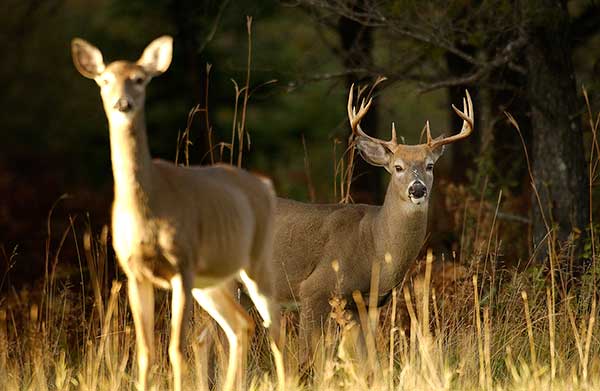- Details
(Provided by Michigan DNR)
The leading reason many individuals participate in deer hunting is simply the opportunity to spend time outdoors with friends and family, but actually harvesting a deer is still very important to many deer hunters. No amount of hunting guarantees a harvest, but preparation and hard work are keys to producing the best chance to see and take deer, or to mentor a new hunter through a safe and enjoyable season. The 2013 deer season is expected to be a successful year for many hunters, and as always, will certainly offer the exciting challenge we call hunting.
Persistence can pay off for deer hunters. Nationwide, successful deer hunters hunt an average of eighteen days slightly more than the average number of days that Michigan deer hunters spent afield last year. However, chances for success are greatest for those who are prepared. Part of hunting preparations each year includes becoming familiar with the most recent regulations. The deer website of the Michigan Department of Natural Resources (DNR) and a collaborative website with the Department of Fisheries and Wildlife at Michigan State University provide highlights of regulations changes, information about deer management, and links to additional resources, such as a list of deer check stations. These sites are located at www.michigan.gov/deer and http://deer.fw.msu.edu.
Please refer to the 2013 Hunting and Trapping Digest and Antlerless Digest, available at DNR Operations Service Centers, license vendors, or available in electronic formats through links at these sites, for a map of all Deer Management Units (DMUs) and other regulations details.
- Details
By Louie Stout
Will Hoosiers set another deer harvest record this season?
Probably not, says Indiana deer biologist Chad Stewart.
Thats not to say he doesnt expect a good hunting season, but the state is due for a dip.
Last year, Hoosiers harvested 136,248 deer, breaking the harvest record for the fourth time in the last five seasons.
It wouldnt surprise me if it was down a little this year, Stewart said in a press release. But I dont expect the harvest numbers to fall off a cliff. There will still be plenty of deer out there.
- Details
 Changes in Michigan deer regulations are coming.There have been some significant changes made to Michigans deer hunting regulations for the 2013 season, so hunters expecting to go about business as usual this fall should take a few minutes to familiarize themselves with the rules.
Changes in Michigan deer regulations are coming.There have been some significant changes made to Michigans deer hunting regulations for the 2013 season, so hunters expecting to go about business as usual this fall should take a few minutes to familiarize themselves with the rules.
The change most likely to affect the most hunters is the creation of new deer management units (DMU) in southern Michigan. There are no antlerless permits for DMU 486, which includes most of southern Michigan, this year. Instead, there are a number of new DMUs which are made up of either single counties or small contiguous groups of counties. There is one four-county DMU (DMU 319) in central southern Michigan, three three-county DMUs, two two-and-a-half-county DMUS, and two two-county DMUS. All other DMUs in the Lower Peninsula are single counties.
DMUs were created based on consistency of deer numbers and other conditions such as the amount of agriculture damage, habitat conditions and urbanization, Rudolph said.
"Essentially, the idea behind the groupings was to provide the largest possible units to give hunters the most flexibility without having to buy multiple tags, he said. So we basically looked at how large we could go and still have consistent conditions within the DMU.
- Details
(Provided by Indiana DNR)
An Indiana program that allows hunters to give deer meat to those who want venison will be available again this fall.
GiveIN Game, DNR Division of Fish & Wildlifes venison donation program, will be available for its third year. Hunters who are willing to donate venison and people who would like to receive venison can begin registering on Sept. 1 at www.hunting.IN.gov/7240.htm.
GiveIN Game makes it easy for people to connect and set up an exchange. Selling, bartering or trading for venison is illegal.
The successful program had 774 participants in 2012, up from 702 participants in 2011.
Both hunters and recipients have an option of donating or requesting any amount of venison in all conditions, from field-dressed animals to packaged venison.
Previous participants must re-register if they want to continue participating.
- Details
Registration is open for a free DNR program that will teach participants how to hunt whitetail deer in Indiana.
Hunt, Fish, Eat is slated for Fort Wayne Sept. 5. The program is a four-session series, with an optional fifth session. Sessions are once a week and offer hands-on learning in a safe environment.
Hunt, Fish, Eat is an opportunity for new hunters ages 18 and older to improve their self-reliance skills and to learn to harvest a delicious source of fresh, local meat.
Curriculum will focus on laws and regulations, firearms and safety, locating a hunting spot, tracking and field dressing your harvest, and handling and preparing your venison for the table.
Each session will include an opportunity to sample venison recipes from instructors, as well as examine a variety of hunting gear and resources.
Participants should attend all sessions. All equipment will be provided.
For more information and to register, go to www.dnr.IN.gov/fishwild/7548.htm.




